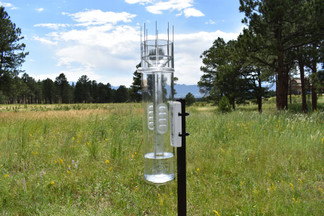Posted by Climalytic Instruments, LLC on 27th Aug 2023
Top 10 TROPO Rain Gauge Tips and Tricks
Tip #1: Decanting
When decanting rainwater or melted snow in the outer tube into the inner tube, make sure you place your thumb over the overflow spout atop the inner tube. This will lower the risk of spilling the water, which obviously leads to inaccurate measurements. Also, to avoid accidental overflows during decanting, fill the inner tube to a point less than 1 inch.
Tip #2: Insects
If you find that insects tend to get trapped in the TROPO inner tube, loop an elastic insect repellent band or bracelet around the top of the gauge. Replace the band frequently for best results. Avoid installing the gauge near a light that naturally attracts bugs at night. We are also exploring debris screening/filtering options that would keep bugs from falling into the inner tube. Before we release these screens, we need to ensure that they won’t negatively affect the catchment of rain.
Tip #3: Surface Tension
The TROPO rain gauge is designed to minimize evaporation loss from the gauge, but sometimes condensation is trapped within the gauge. This causes water droplets to cling to the sides of the tubes due to surface tension. Given the precision of the TROPO rain gauge, this condensation will not negatively impact your measurements. With that said, if there seems to be an excessive amount of condensation, you can round up your measurement to the nearest 0.01 inch. To minimize the surface tension of the water, try using Rain-X® Plastic Water Repellent Trigger. This product is specifically designed to repel water from polycarbonate plastic and it will not harm the gauge. Another alternative is to use a scale to measure the mass/weight of the gauge (in grams), subtract the dry weight of the gauge (in grams) then divide the difference by 206 grams to calculate the depth of precipitation in inches.
Tip #4: Bird Deterrent Rods
While optional, it’s best to use the stainless steel bird deterrent rods. When decanting the Stratus gauge, it was often easiest to use the top cap as a funnel. When doing this with the TROPO rain gauge, it can be rather tricky with the bird deterrent rods installed. This method of decanting, however, is not necessary anymore, given that the TROPO rain gauge features a funnel atop the inner cylinder (see tip #1). Plus, the rods may even act as a mini rain gauge shield (also known as a wind shield) which is a “device that surrounds a rain gauge and acts to maintain horizontal flow in the vicinity of the funnel so that the catch will not be influenced by eddies generated near the gauge.”
Tip #5: Cleaning
Keep the gauge clean by using the supplied brush, a small amount of dish soap and warm tap water to ensure accurate measurements. Do not use chemicals or solvents, as they may degrade the plastic. Just don’t forget to shake out the excess water before re-installing the gauge!
Tip #6: UV Protection
The TROPO rain gauge is constructed of a high quality UV-stabilized polycarbonate plastic, the same material used to make greenhouses. However, to reduce solar exposure, position the gauge on the north side of the pole or post it is mounted to (assuming you’re in the northern hemisphere).
Tip #7: Mounting Bracket
When installing the TROPO mounting bracket onto a post, make sure not to over tighten the screws. Doing so may cause the bracket to crack. It is easy to over tighten the screws with a power drill or driver, so we recommend any tightening be manually with a Phillips-head screwdriver. Another tip is to install the top screw first. Then, while using the supplied bubble level, make sure the mount is level before installing the second/bottom screw.
Tip #8: Adhesive Pad
When installing the adhesive pad to the curved back of the TROPO mounting bracket, peel back only half (long-wise) of the paper backing. Affix the sticky portion along the long edge of the bracket, making sure to push the backing firmly into the curved section of the bracket. Then, remove the remaining paper backing and firmly push the pad into place while avoiding air gaps between the pad and curved portion of the mounting bracket. This will ensure a nice, straight and gap-free installation.
Tip #9: Rain at Observation Time
To avoid missing rainfall during a downpour at your observation time, take an accurate reading (if less than 1”) or an approximate reading (via the outer tube gradations), but don’t empty the gauge. Instead, wait until the storm is over or during your next regular observation time to calculate how much rain has fallen since your last reading.
Tip #10: Extra Outer Tubes
For those of you in snowy locations, it is extremely helpful to have an extra outer TROPO tube for making snow core samples. This way, you can leave the mounted gauge in place for measuring the “gauge catch.” A second outer tube is also handy for swapping out with the mounted gauge to allow the snow/ice to melt in one tube, while the other remains outside collecting new snow/ice.

